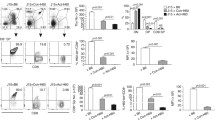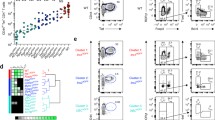Abstract
We have investigated primary and secondary responses of mouse splenic T cells to strong mixed lymphocyte stimulating antigens controlled by theMls locus using MHC-identical mixtures of cells. Our studies show that strong primaryMls-locus specific responses involve recognition of self I-A antigens, since BUdR and light suicide or F1 into parent radiation bone-marrow chimeras both demonstrate a preference of unprimed F1 T cells to respond to Mis-locus antigens associated with one parent's MHC antigens. Furthermore, conventional anti-I-A antisera and monoclonal anti-I-A antibody both inhibitMls-locus responses in an MHC-specific manner. Finally, as is typical of T cells responding to I-A antigens or to nominal antigens associated with self I-A,Mlslocus responses are mediated by Lyt-1+, 2− cells. One striking finding in these studies was the very high frequency of cells capable of responding to Mls-locus antigens, the highest being 1/300 splenic T cells. This plus evidence for recruitment during primaryMls-locus responses may account for reports of a lack ofI-A restriction in secondary anti-Mls locus responses to strong Mls-locus antigens, a finding with which we concur. The possibility that these secondary responses between noncongenic strains of mice may be directed at other genetic loci is also discussed. These experiments leave open the question of the biological role of theMls-locus and of the very large number of T cells reactive to it.
Similar content being viewed by others
Abbreviations
- MHC:
-
Major histocompatibility complex
- MIg:
-
Mouse immunoglobulin
- MLC:
-
Mixed lymphocyte culture
- TCGF:
-
T-cell growth factor
References
Bach, F. H., Widmer, M. B., Segall, M., Bach, M. L., and Klein, J.: Genetic and immunological complexity of the major histocompatibility regions.Science 176: 1024, 1972
Binz, H. and Wigzell, H.: Antigen-binding, idiotypic T-lymphocyte receptors.Contemp. Top. Immunobiol. 7: 113–177, 1977
Cantor, H. and Boyse, E. A.: Regulation of the immune response by T cell subclasses.Contemp. Top. Immunobiol. 7: 47–67, 1977
Click, R. E., Benck, L., and Alter, B. J.: Immune responsesin vitro. I. Culture conditions for antibody synthesis.Cell. Immunol. 3: 264, 1972
Corley, R. B.: Responses of alloantigen-primed lymphocytesin vitro: Quantitative analysis of the relative frequency of reactive lymphocytes in primed populations which respond to allogeneic stimulating cells.Eur. J. Immunol. 7: 93–99, 1977
Delovitch, T. L. and Sohn, U.:In vitro analysis of allogeneic lymphocyte interaction. IV. Dual recognition of B cell associated Mis-locus and I-region determinants by a helper allogeneic effect factor generated across a minor H locus disparity.J. Immunol. 123: 121–127, 1979
Doherty, P. C., Götze, D., Trinchieri, G., and Zinkernagel, R.: Models for recognition of virally modified cells by immune thymus-derived lymphocytes.Immunogenetics 3: 517–524, 1976
Festenstein, H.: Immunogenetic and biological aspects ofin vitro lymphocyte allotransformation (MLR) in the mouse.Transplant. Rev. 15: 62, 1973
Festenstein, H., Bishop, C., and Taylor, B. A.: Location ofMls locus on mouse chromosome 1.Immunogenetics 5: 357–361, 1977
Janeway, C. A., Jr.: Cellular cooperation duringin vivo anti-hapten antibody responses. I. The effect of cell number on the response.J. Immunol. 114: 1394–1401, 1975
Janeway, C. A., Jr.: Specific and non-specific cooperation between M-locus-incompatible T and B cells during adoptive anti-hapten antibody responses in mice.Scand. J. Immunol. 5: 593–596, 1976
Janeway, C. A., Jr., Wigzell, H., and Binz, H.: Hypothesis: Two different VH gene products make up the T cell receptors.Scand. J. Immunol. 5: 993, 1976
Janeway, C. A., Jr., Murphy, P. D., Kemp, J., and Wigzell, H.: T cells specific for hapten-modified self are precommitted for self major histocompatibility complex antigens before encounter with the hapten.J. Exp. Med. 147: 1065–1077, 1978
Janeway, C. A., Jr., Bert, D. L., and Shen, F.-W.: Cell cooperation duringin vivo antihapten antibody responses. V. Two synergistic Lyl+, 23− helper T cells with distinctive specificities.Eur. J. Immunol., in press, 1980
Kappler, J. W. and Marrack, P. C.: The role of H-2 linked genes in helper T-cell function. IV. Importance of T cell genotype and host environment in I-region and Ir gene expression.J. Exp. Med. 148: 1510, 1978
Kastner, D. L., Rich, R. R., Chu, L., and Rich, S. S.: Regulatory mechanisms in cell-mediated immune responses. V. H-2 homology requirements for the production of a minor locus-induced suppressor factor.J. Exp. Med. 146: 1152–1157, 1977
Katz, D. H., Hamaoka, T., Dorf, M. E., and Benacerraf, B.: Cell interactions between histoincompatible T and B lymphocytes. III. Demonstration that the H-2 gene complex determines successful physiologic lymphocyte interactions.Proc. Natl. Acad. Sci. (U.S.A.) 70: 2624, 1973
Langman, R. E.: The role of the major histocompatibility complex in immunity: A new concept in the functioning of a cell-mediated immune system.Rev. Physiol. Biochem. Pharmacol. 81: 1, 1978
Molnar-Kimber, K. and Sprent, J.: Absence of H-2 restriction in primary and secondary mixed lymphocyte reactions to strong Mls determinants.J. Exp. Med., in press, 1980
Mosier, D. E. and Coppleson, L. W.: A three-cell interaction required for the induction of the primary immune responsein vitro.Proc. Natl. Acad. Sci. (U.S.A.).61: 542–547, 1968
Peck, A. B., Wigzell, H., Janeway, C. A., Jr., and Andersson, L. C.. Environmental and genetic control of T cell activationin vitro: a study using isolated alloantigen activated T cell clones.Immunol. Rev. 35: 146–180, 1977 a
Peck, A. B., Janeway, C. A., Jr., and Wigzell, H.: T lymphocyte responses to Mls locus antigens involve recognition of H-2 I region gene products.Nature 266: 840–842, 1977 b
Peck, A. B., Murgita, R. A., and Wigzell, H.: Cellular and genetic restrictions in the immunoregulatory activity of alpha-fetoprotein. II. Alpha-fetoprotein-induced suppression of cytotoxic T lymphocyte development.J. Exp. Med. 148: 360–372, 1978
Ryser, J.-E. and MacDonald, H. R.: Limiting dilution analysis of alloantigen-reactive lymphocytes. I. Comparison of precursor frequencies for proliferative and cytolytic responses.J. Immunol. 122: 1691–1696, 1979
von Boehmer, H., Haas, W., and Jerne, N. K.: Major histocompatibility complex-linked immune-sresponsiveness is acquired by lymphocytes of low responder mice differentiating in thymus of high responder mice.Proc. Natl. Acad. Sci. (U.S.A.).75: 2439–2442, 1978
Wigzell, H.: Specific affinity fractionation of lymphocytes using glass or plastic bead columns.In B. R. Bloom and J. R. David (eds.):In Vitro Methods in Cell Mediated and Tumor Immunity, pp. 245–254, Academic Press, New York, 1976
Wilson, D. B., Blyth, J. L., and Nowell, P. C.: Quantitative studies on the mixed lymphocyte reaction. III. Kinetics of the response.J. Exp. Med. 128: 1157, 1968
Zinkernagel, R. M. and Doherty, P. C.: MHC-restricted cytotoxic T cells: studies on the biological role of polymorphic major transplantation antigens determining T-cell restriction-specificity, function, and responsiveness.Adv. Immunol. 27: 51–177, 1979
Author information
Authors and Affiliations
Rights and permissions
About this article
Cite this article
Janeway, C.A., Lerner, E.A., Jason, J.M. et al. T lymphocytes responding to Mls-locus antigens are Lyt-1+, 2− andI-A restricted. Immunogenetics 10, 481–497 (1980). https://doi.org/10.1007/BF01572583
Received:
Revised:
Issue Date:
DOI: https://doi.org/10.1007/BF01572583




